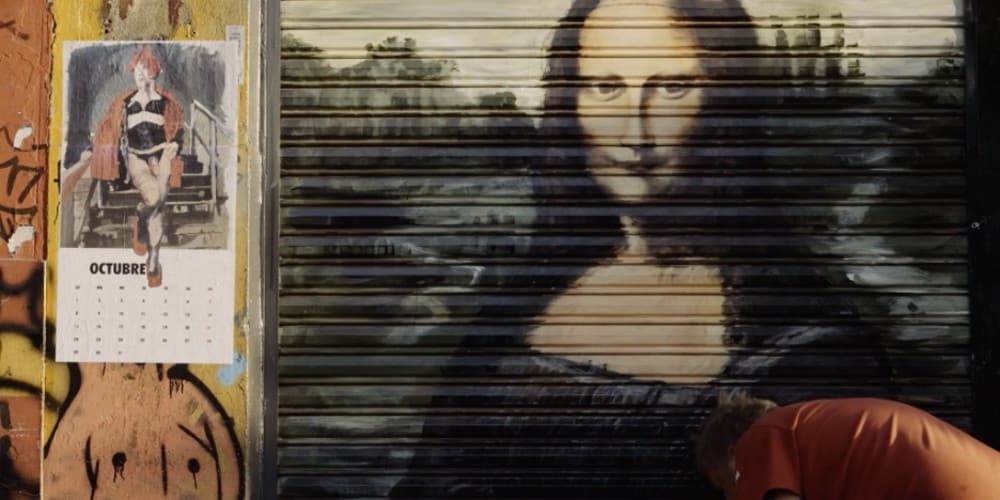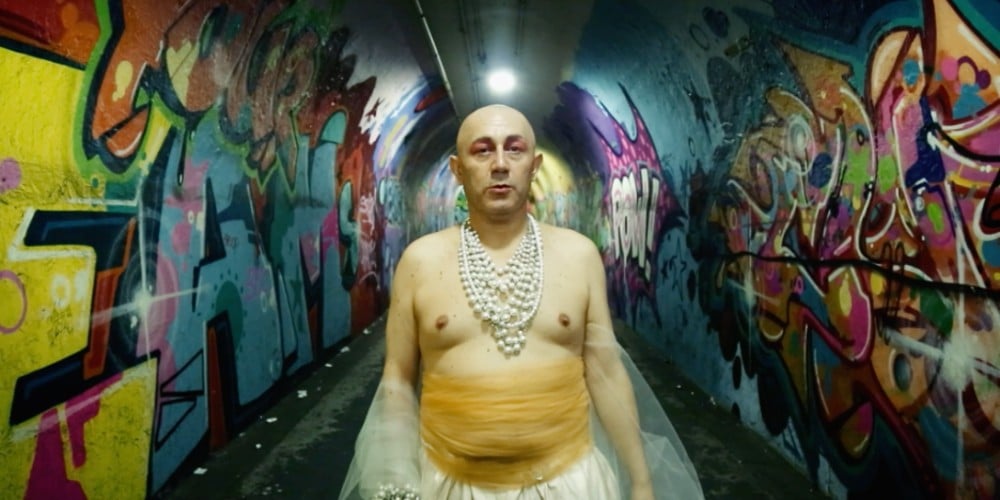Nicole Costa’s documentary about the life and times of poet, artist, friend, and sex worker Iván Monalisa is insightful and wry.
(This review is part of our 2021 coverage of Reeling: The Chicago LGBTQ+ International Film Festival)
The title says all about The Journey of Monalisa. Nicole Costa’s poetic, thought-provoking documentary is about the journey and process of Iván Ojeda becoming Iván Monalisa Ojeda. Originally from Chile, Iván Monalisa has been living in the United States as an undocumented sex worker since the late 1990s, writing poems and performing art pieces about their experiences. After some twenty years in The States, they’re able, through The Urban Justice Center, to change both their citizenship and gender permanently.
Like La Joconde herself, Monalisa is always Art. The picture follows her as she walks New York City, a long braid behind her, collecting the grime and life of the streets as she goes. Her poetry provides meditative intertitles that allude to a depth of feeling swimming under the next chapter in her story. Often, her candid moments merge into poetic philosophies—and like any poet, she sometimes speaks in “lines.”

Sadly, The Journey doesn’t fully explore Iván Monalisa’s art practice, choosing instead to focus mostly on her life as a sex worker. It would have made for a more detailed portrait of the enigmatic person being celebrated as an artist if we learned more of their thoughts on the workings of performance and poetry or how she views her craft. Monalisa has something to say and a queer audience she wants to reach with her art. It would have been nice to have this queer elder’s ideas on art and praxis archived for future queer generations.
Still, The Journey of Monalisa has a peculiar, sly smile to it. Costa has known Iván Monalisa since their days in school together at The University of Chile where Iván was a student sensation. There’s an already-established intimacy that helps the documentary feel personal and not devoutly somber.
It would have been nice to have this queer elder’s ideas on art and praxis archived for future queer generations.
Though both Iván Monalisa and Costa are serious about their work, they’re not without a sense of humor about themselves and the fact that they’re making a documentary. Monalisa is wickedly candid at times about both herself and her clients. And both she and Costa are acutely aware of the hilarious, often grotesque, angles being used to lean into caricaturesque humor.
Outside of Costa’s own up-close filmmaking, the film relies heavily on the archival footage shot by a friend of Iván’s who brought a video recorder anytime they went out. Costa can collage together a tableau vIvánt of the cultures that produced Iván Monalisa out of miles and miles of rare footage documenting the trans-inclusive New York nightlife of the 1990s. It challenges the popular notion of it means to live an undocumented life. Yes, Iván was living in the US without proper citizen documents, yet his life is well documented because of his friends and the camcorder. Such wealth of footage helps us visually watch the journey of Monalisa happen over time while drawing important parallels to the way both she and culture have changed.
Though both Iván Monalisa and Costa are serious about their work, they’re not without a sense of humor about themselves and the fact that they’re making a documentary.
It’s not joyous all the time though. For Iván, Monalisa is oftentimes an enemy, someone who causes him to sometimes endure tremendous personal, spiritual, and social suffering. During one extended, if slightly awkward sequence, Iván Monalisa explains his preference for “Two-Spirit” because of the way it accounts for the internal duality he feels. If they could choose a third option, Iván Monalisa would identify as gender non-conforming because they feel an oppositional divide between his masculine and feminine sides.
This opens more questions to consider long after The Journey of Monalisa has finished. Iván Monalisa crossed borders and genders, so it’s logical for him to see them as mutually malleable. Yet for many, including Indigenous folks in North America, borders crossed them. Land matters. It plays a real part in identity formation.

“Physical territory is only a mental state. My identity is my true territory and it doesn’t belong to any one place…I’m my discovery” Iván Monalisa says as The Journey comes to a close. It’s a profound statement that at simultaneously explains how Monalisa sees nationality and gender identity as related, even coterminous. It’s an interesting insight into what transgender transnationalism might look and live like.
In spite and because of this, what remains astonishing about The Journey of Monalisa is the way it explicitly, though somewhat haphazardly, ties the process of changing borders and changing genders. For Iván Monalisa, this is a symbiotic journey. Changing one allows them to change the other. And while they would have preferred to have been listed as gender non-conforming rather than singularly F for female, it’s nevertheless an emotional conclusion for Iván Monalisa to have two dreams of being recognized simultaneously come true.
The Journey of Monalisa Trailer:
Read next: The Spool's Best New Releases
Streaming guides
The Best Live TV Streaming Services With Free Trial
The praises of live TV streaming services don’t need to be further sung. By now, we all know that compared to clunky, commitment-heavy cable, live TV is cheaper and much easier to manage. But just in case you’re still on the fence about jumping over to the other side, or if you’re just unhappy with ... The Best Live TV Streaming Services With Free Trial
How to Watch Power Book III: Raising Kanan Season 3
Season 3 of the hotly anticipated Power spin-off, Power Book III: Raising Kanan, is arriving on Starz soon, so you know what that means: it’s the ’90s again in The Southside, and we’re back with the Thomas family as they navigate the ins and outs of the criminal underworld they’re helping build. Mekai Curtis is ... How to Watch Power Book III: Raising Kanan Season 3
How to Watch Doctor Who: 60th Anniversary Specials
Ladies and gentlemen, we’re so back! To celebrate Doctor Who’s 60th anniversary, the BBC is producing a three-episode special starring none other than the Tenth/Fourteenth Doctor himself, David Tennant. And to the supreme delight of fans (that would be me, dear reader), the Doctor will be joined by old-time companion Donna Noble (Catherine Tate) and ... How to Watch Doctor Who: 60th Anniversary Specials
Which Netflix Country has Interstellar?
Maybe you’ve just seen Oppenheimer and have the strongest urge to marathon—or more fun yet, rank!—all of Christopher Nolan’s films. Or maybe you’re one of the few who haven’t seen Interstellar yet. If you are, then you should change that immediately; the dystopian epic is one of Nolan’s best, and with that incredible twist in ... Which Netflix Country has Interstellar?
Which Netflix Country Has Each Movie of The Hunger Games?
For whatever reason, The Hunger Games series isn’t available in the same countries around the world. You’ll find the first and second (aka the best) installments in Hong Kong, for instance, but not the third and fourth. It’s a frustrating dilemma, especially if you don’t even have a single entry in your region, which is ... Which Netflix Country Has Each Movie of The Hunger Games?
How to Watch ESPN With A Free Trial
One of the major concerns people have before cutting the cord is potentially losing access to live sports. But the great thing about live TV streaming services is that you never lose that access. Minus the contracts and complications of cable, these streaming services connect you to a host of live channels, including ESPN. So ... How to Watch ESPN With A Free Trial
How to Watch Paramount Network With a Free Trial
To date, Paramount Network has only two original shows on air right now: Yellowstone and Bar Rescue. The network seems to have its hands full with on-demand streaming service Paramount+, which is constantly stacked with a fresh supply of new shows. But Yellowstone and Bar Rescue are so sturdy and expansive that the network doesn’t ... How to Watch Paramount Network With a Free Trial
How to Watch WE TV With a Free Trial
Previously “Women’s Entertainment,” We TV has since rebranded to accurately reflect its name and be a more inclusive lifestyle channel. It’s home to addictive reality gems like Bold and Bougie, Bridezillas, Marriage Boot Camp, and The Untold Stories of Hip Hop. And when it’s not airing original titles, it has on syndicated shows like 9-1-1, ... How to Watch WE TV With a Free Trial
How to Watch TNT Sports With A Free Trial
For many sports fans, TNT is a non-negotiable. It broadcasts NBA, MLB, NHL, college basketball, and All Elite Wrestling matches. And, as a bonus, it also has reruns of shows like Supernatural, Charmed, and NCIS, as well as films like The Avengers, Dune, and Justice League. But while TNT used to be a cable staple, ... How to Watch TNT Sports With A Free Trial
How to Watch Comedy Central With a Free Trial
It’s no coincidence that many of today’s biggest comedians found their footing on Comedy Central: the channel is a bastion of emerging comic talents. It served as a playground for people like Nathan Fielder (Fielder For You), Ilana Glazer and Abbi Jacobson (Broad City), Tim Robinson (Detroiters), and Dave Chappelle (Chappelle’s Show) before they shot ... How to Watch Comedy Central With a Free Trial
How to Watch FX With a Free Trial
You’d be hard-pressed to find a bad show airing on FX. The channel has made a name for itself as a bastion of high-brow TV, along with HBO and AMC. It’s produced shows like Atlanta, Fargo, The Americans, Archer, and more recently, Shogun. But because it’s owned by Disney, it still airs several blockbusters in ... How to Watch FX With a Free Trial